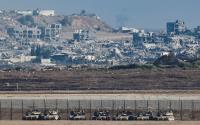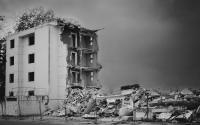29 June 2006Znet
“I am sorry with all my heart for the residents of Gaza… but the lives and well-being of Sderot’s residents are more important than those of Gaza residents.” Ehud Olmert
"Better Palestinian mothers should cry and not Jewish mothers"-Major General Aharon Ze'evi, Israel's director of military intelligence 2003
"I wish Gaza would sink into the sea." – late Israeli Prime Minister Yitzhak Rabin, 1992
“We believe that one primary, unstated motive for the determination of the government of the State of Israel to get the Jewish settlers of the Qatif (Katif) settlement block out of the Gaza Strip may be to keep them out of harm's way when the Israeli government and military possibly trigger an intensified mass attack on the approximately one and a half million Palestinians in the Gaza Strip, of whom about half are 1948 Palestine refugees. The scenario could be similar to what has already happened in the past - a tactic that Ariel Sharon has used many times in his military career - i.e., utilizing provocation in order to launch massive attacks.”
Uri Davis, Ilan Pappe, Tamar Yaron – July, 2005
Israel and Gaza’s Population
Israel’s policy towards Gaza has been in place for some time. It was in place before Israel arrested some 20 members of the Palestinian elected government on June 28 and some 40 other Palestinians throughout the territory it occupies. It was the case before Israel re-invaded Gaza with 5000 troops on June 27, before it bombed the Strip’s only electrical generating station (depriving about a half a million people of electricity). Human Rights Watch noted about this that: “The destruction of the power station could quickly cause a humanitarian crisis in Gaza, as electricity is essential to power the water system, sewage treatment, and medical services”. In the same attack Israel destroyed 3 bridges, and the main water pipes for two densely populated refugee camps (Nuseirat and El Bureij).
Israel’s Gaza policy is the same as it was before Palestinians took an Israeli tank gunner and French citizen Corporal Gilad Shalit prisoner in an attack on a checkpoint in occupied territory on June 25, in an operation that killed 2 other Israeli soldiers and 2 Palestinians. Those who took the gunner prisoner want to exchange him for about 400 Palestinian children and 100 women imprisoned in Israel (there are about 9000 adult male Palestinan prisoners in Israel, 1000 of whom are in ‘administrative detention’ and have never been charged, much less tried, for any crimes).
Israel’s policy was in place even before Israel shelled the Beit Lahiya beach on June 9, killing 8 civilians and injuring 32 including 13 children, then massacred 11 more civilians and injured 30 more on June 13, then massacred 3 more kids and injured 15 others in a missile attack on June 20, and then killed another pregnant woman and a man in yet another missile attack on June 21, then sent soldiers into Gaza on an ‘incursion’ to arrest Palestinians on June 24.
Gaza has always played a different role in the minds of Israel’s planners. In 2003, when he was vice prime minister, Israel’s current PM Ehud Olmert summarized the disengagement plan as “Maximum Jews, Minimum Arabs”. Israel wants the land but not the people. In Gaza, however, Israel wants neither the land nor the people, as Rabin’s comment suggested in 1992, and as Israel’s evacuation of their settlements in Gaza suggested last year.
When the construction of the West Bank Wall began in earnest in 2002, Gaza’s 1.25 million people were already completely surrounded by electric fences. When closures and sieges in the West Bank were destroying the economy of that territory, Gaza’s economy had already completely collapsed, its residents dependent on external aid and their own traditions of self-help and hospitality for survival, with virtually complete unemployment, 75% poverty and, in 2003, according to the UN Special Rapporteur for food and USAID, 22% of children starving. The World Bank reported this situation was the direct result of Israel’s closures.
The 22% figure comes from 2003 – that is before the EU and others decided to cut aid to Palestinians after they elected the wrong people, before senior advisor to Sharon Dov Weisglass publicly announced the plan to "put Palestinians on a diet but not make them die of hunger." In June 2006, the World Food Program reported that 51% of Palestinians – 2 million people – were unable to meet their food needs without aid, and that in Gaza, “the situation is becoming critical”
This is the context in which the new invasion of Gaza is taking place. The capture of Cpl. Shalit on June 25 cannot have been the cause of the thousands of shells and the 80+ air strikes Israel has rained down on Gaza since the settlers left last year.
Israel’s policy toward the entire population of Gaza is one of shelling, bombing, massacre, destruction of civilian infrastructure, closure, and starvation. Its policy toward the Palestinian leadership is one of assassination and imprisonment. Events throughout this month show the convergence of these policies in Gaza. Even a cursory look at events in order in the past month alone shows that Israel’s Gaza invasion is not motivated by the capture of Shalit.
June in Gaza
On June 8, the Israeli army assassinated Jamal Abu Samhadana of the Popular Resistance Committees, who had just been appointed head of the security forces of the Interior Ministry by the Palestinian government, and three others. On June 9, 30,000 Palestinians attended the funeral.
That same day, June 9, an Israeli gunboat stationed off the coast of the Beit Lahiya beach fired seven artillery shells at Palestinian families on a picnic on the beach, wiping out one family. The shells killed a mother (Ra’eesa Ghaila), a father (Ali Issa Gahlia), and five children (Haitham, Hanadi, Sabreen, Ilham, Alia) and wounded 32 others, including 13 children.
On June 13, an Israeli plane fired a missile into a busy Gaza City street and killed 11 people, including two children and two medics, in two waves. The first missile killed several. Then, when others came to the scene to help, they were killed by a second missile.
According to the Israeli military, these attacks were in retaliation for homemade rockets fired from Gaza at the Sderot settlement, though military spokespeople rarely refer to injury or fatality statistics due to these rockets (8 Israelis have been killed by Qassam rockets in the past 5 years). The Israeli defence minister, discussing Israel’s new killings, said "we have been showing restraint due to the international storm caused by the incident on the Gaza beach - but no longer."
On June 20, the Israeli army, attempting to assassinate a Palestinian adult, killed three Palestinian children (Mohammad Jamal Shukri Rouqa, 6, Samia Mahmoud Ziad al-Sharif, 5, and Bilal Jasser al-Hissi, 16) and injured 15 others in Gaza with a missile attack.
On June 21, the Israelis attacked Khan Yunis with a missile and killed a 35-year old pregnant woman, Fatmeh Ahmad, killed her brother Zachariya Ahmad, and injured 11 others, including 6 children.
Then, on June 25, a group of Palestinians attacked an Israeli military checkpoint. They killed two soldiers, captured one, and lost two of their own. Having been captured during a military operation, Cpl. Shalit became a hostage when the Palestinians offered to trade him for the 400 children and 100 women Israel has imprisoned. Israel replied, on June 28, by taking hostages of its own – including several dozen members of the elected government – and offering (on June 29) to trade these new hostages, not the women and children, for Shalit. The new Palestinian hostages, however, were probably not captured as bargaining chips, but as a move to ‘regime change’. In addition to assassinating and taking members of the government, Israel launched an air strike on the Palestinian interior ministry.
After the month just described, the Palestinian operation of June 25 is the one described in the media as an “escalation” in the conflict.
Escalation did come, however, as it had weeks before, from Israel, which launched the air strikes and the invasion that are now ongoing. Photos of Israeli soldiers preparing for the invasion suggest a celebratory atmosphere that does not bode well for any of those who are likely to suffer from this escalation. (First, Second, Third photo)
Whether the invasion compels Palestinians to release Cpl. Shalit or endangers his life further, it has already cost several Palestinians and one Israeli their lives. But Electronic Intifada writer Rifat Odeh Kassis quotes an Israeli military spokesman saying that Cpl. Shalit and the Gaza invasion are ‘two different stories’: “In other words Gaza will be invaded one way or the other. According to Israeli daily, Yediot Ahronot, the invasion of Gaza was planned much earlier than the kidnapping of the soldier. This means not only will child prisoners not be released in exchange for the soldier’s life, but more children will most likely be killed in the coming invasion.”
If the release of Cpl. Shalit cannot end the invasion, how will it come to an end? All the brutality toward the people of Gaza has not made them compliant. Dr. Mona Elfarra of the al-Awda hospital in the Jabaliya refugee camp told Democracy Now: “You can see twenty -- 2,000 people last night demonstrated in the middle camps of Gaza Strip against the release of the soldier, or the release of the soldier in swap of the political prisoners.”
Past Israeli governments have negotiated for Israeli soldiers, but the “Hannibal Directive”, reported by Chris McGreal, suggests that the Israeli invasion is setting up a more tragic outcome for everyone involved.
The invasion escalates Gaza’s desperate situation. Dr. Mona Elfarra notes: “Al-Awda Hospital's mediction supplies are enough for only one week of routine use. If the operation continues and casualty numbers increase, I am warning that a health disaster will follow.”
The terrible disproportion of this invasion could be the result of opportunism, taking advantage of the capture of a soldier to decapitate a people of their leadership and advance a program of mass starvation and murder, based on a twisted moral calculus that values some lives and not others. That moral calculus seems to have been adopted the world over, with a few exceptions. Palestinians’ chances of survival are tied to these exceptions, as well as their own resistance.
* * *
PRCS Figures:
June 5 – 2June 7 – 3June 8 – 4June 9 – 11June 10 – 1June 11 – 3June 13 – 11June 14 – 1June 15 – 2June 16 – 2June 20 – 3June 21 – 3June 22 – 1June 25 – 2June 27 – 1June 28 – 3
49 Palestinians were killed in the conflict in June, throughout the territories, before June 25. The total tally of Palestinians killed directly since September 2000 is 3967.
Appendix 2: Btselem’s list of Palestinian casualties in Gaza to June 15, 2006
Salem Muhammad Salem Abu Zabeidah22 year-old resident of al-Bureij Refugee Camp, Deir al-Balah district, killed on 15.06.2006 in Deir al-Balah by gunfire from a helicopter. Killed when participating in hostilities. Additional information: Killed during an attempt to plant explosives near the Gaza perimeter fence, north of Kissufim.
Muhammad Mahmoud Rajab Tanjarah22 year-old resident of al-Bureij Refugee Camp, Deir al-Balah district, killed on 15.06.2006 in Deir al-Balah by gunfire from a helicopter. Killed when participating in hostilities. Additional information: Killed during an attempt to plant explosives near the Gaza perimeter fence, north of Kissufim.
'Ali 'Ali Hussein al-'Umari32 year-old resident of Beit Lahiya, North Gaza district, killed on 13.06.2006 in Gaza city by gunfire from a helicopter. Did not participate in hostilities when killed. Additional information: Killed when the Israeli airforce fired missiles into a residential neighborhood in northern Gaza city.
Shauqi 'Ali 'Omar a-Seikali41 year-old resident of Gaza city, killed on 13.06.2006 in Gaza city by gunfire from a helicopter. Did not participate in hostilities when killed. Additional information: Killed when the Israeli airforce fired missiles into a residential neighborhood in northern Gaza city.
Rafiq Muhammad Faraj al-Mabid17 year-old resident of Gaza city, killed on 13.06.2006 in Gaza city by gunfire from a helicopter. Did not participate in hostilities when killed. Additional information: Killed when the Israeli airforce fired missiles into a residential neighborhood in northern Gaza city.
Mussa Muhammad Mussa Nasrallah21 year-old resident of Gaza city, killed on 13.06.2006 in Gaza city by gunfire from a helicopter. Did not participate in hostilities when killed. Additional information: Killed when the Israeli airforce fired missiles into a residential neighborhood in northern Gaza city.
'Adnan Da'ud Hassan Taleb46 year-old resident of Gaza city, killed on 13.06.2006 in Gaza city by gunfire from a helicopter. Did not participate in hostilities when killed. Additional information: Killed when the Israeli airforce fired missiles into a residential neighborhood in northern Gaza city.
Husam Isma'il 'Abd a-Rahman Hamad37 year-old resident of Gaza city, killed on 13.06.2006 in Gaza city by gunfire from a helicopter. Did not participate in hostilities when killed. Additional information: Killed when the Israeli airforce fired missiles into a residential neighborhood in northern Gaza city.
Ashraf Faruk 'Ali al-Mughrabi39 year-old resident of Gaza city, killed on 13.06.2006 in Gaza city by gunfire from a helicopter. Did not participate in hostilities when killed. Additional information: Killed when the Israeli airforce fired missiles into a residential neighborhood in northern Gaza city.
Maher Ashraf Faruk al-Mughrabi7 year-old resident of Gaza city, killed on 13.06.2006 in Gaza city by gunfire from a helicopter. Did not participate in hostilities when killed. Additional information: Killed when the Israeli airforce fired missiles into a residential neighborhood in northern Gaza city.
Hisham Rajab Muhammad al-Mughrabi14 year-old resident of Gaza city, killed on 13.06.2006 in Gaza city by gunfire from a helicopter. Did not participate in hostilities when killed. Additional information: Killed when the Israeli airforce fired missiles into a residential neighborhood in northern Gaza city.
Muhammad Hussein Faraj al-wadiyah24 year-old resident of Gaza city, killed on 13.06.2006 in Gaza city by gunfire from a helicopter. Killed when participating in hostilities. Additional information: Killed on his way to fire a Qassam rocket.
Ibrahim Ibrahim a-Da'alseh Muhammad38 year-old resident of Gaza city, killed on 13.06.2006 in Gaza city by gunfire from a helicopter. Did not participate in hostilities when killed. Additional information: Killed when the Israeli airforce fired missiles into a residential neighborhood in northern Gaza city.
Salem Muhammad Zaki a-Radi'a20 year-old resident of Beit Lahiya, North Gaza district, killed on 11.06.2006 in Beit Lahiya, North Gaza district, by gunfire from a helicopter. Killed when participating in hostilities. Additional information: Killed on his way to fire a Qassam rocket.
Muhammad Bachar Mussa al-Masri21 year-old resident of Beit Lahiya, North Gaza district, killed on 11.06.2006 in Beit Lahiya, North Gaza district, by gunfire from a helicopter. Killed when participating in hostilities. Additional information: Killed while he tried to fire a Qassam rocket.
Khaled Yusef Ahmad a-Z'anin44 year-old resident of Beit Hanun, North Gaza district, killed on 09.06.2006 in Jabalya Refugee Camp, North Gaza district, by gunfire from a helicopter. Did not participate in hostilities when killed.
Ahmad 'Ata Zaid a-Z'anin21 year-old resident of Beit Hanun, North Gaza district, killed on 09.06.2006 in Jabalya Refugee Camp, North Gaza district, by gunfire from a helicopter. Did not participate in hostilities when killed. Additional information: Killed on his way home, after driving an injured person to the hospital.
Basel 'Ata Zaid a-Z'anin27 year-old resident of Beit Hanun, North Gaza district, killed on 09.06.2006 in Jabalya Refugee Camp, North Gaza district, by gunfire from a helicopter. Did not participate in hostilities when killed. Additional information: Killed on his way home, after driving an injured person to the hospital.
Muhammad Khalil Muhammad 'Asaliyah19 year-old resident of Gaza city, killed on 08.06.2006 in Rafah by gunfire from a helicopter. Killed when participating in hostilities. Additional information: Killed while attending a training center belonging to the Popular Resistance Committees.
Jamal 'Ataya Zaid Abu Samhadaneh (Abu 'Ataya)43 year-old resident of Rafah Refugee Camp, killed on 08.06.2006 in Rafah by gunfire from a helicopter. Killed when participating in hostilities. Additional information: Killed while attending a training center belonging to the Popular Resistance Committees.
Ahmad Muhammad Murjan Abu Sitah28 year-old resident of Rafah Refugee Camp, killed on 08.06.2006 in Rafah by gunfire from a helicopter. Killed when participating in hostilities. Additional information: Killed while attending a training center belonging to the Popular Resistance Committees.
Nidal Nabil Muhammad Mussa21 year-old resident of Rafah, killed on 08.06.2006 in Rafah by gunfire from a helicopter. Killed when participating in hostilities. Additional information: Killed while attending a training center belonging to the Popular Resistance Committees.
Anwar S'ud Suleiman Abu Sala'h35 year-old resident of Jabalya Refugee Camp, North Gaza district, killed on 07.06.2006 in Gaza city by gunfire from a helicopter. Additional information: Killed while trying to infiltrate into Israel.
Riad Hammad Msalam Abu Sala'h37 year-old resident of Jabalya Refugee Camp, North Gaza district, killed on 07.06.2006 in Gaza city by gunfire from a helicopter. Additional information: Killed while trying to infiltrate into Israel.
Khader Hamdi 'Abdallah Qassem24 year-old, killed on 07.06.2006 in Gaza city by gunfire from a helicopter. Did not participate in hostilities when killed. Additional information: An Palestinian police man.
'Imad Muhammad 'Ali 'Asaliyah26 year-old resident of Jabalya, North Gaza district, killed on 05.06.2006 in Jabalya Refugee Camp, North Gaza district, by gunfire from a helicopter. He was the target of an assasination.
Majdi Taysir Hassan Hammad29 year-old resident of Jabalya, North Gaza district, killed on 05.06.2006 in Jabalya Refugee Camp, North Gaza district, by gunfire. He was the target of an assasination.






